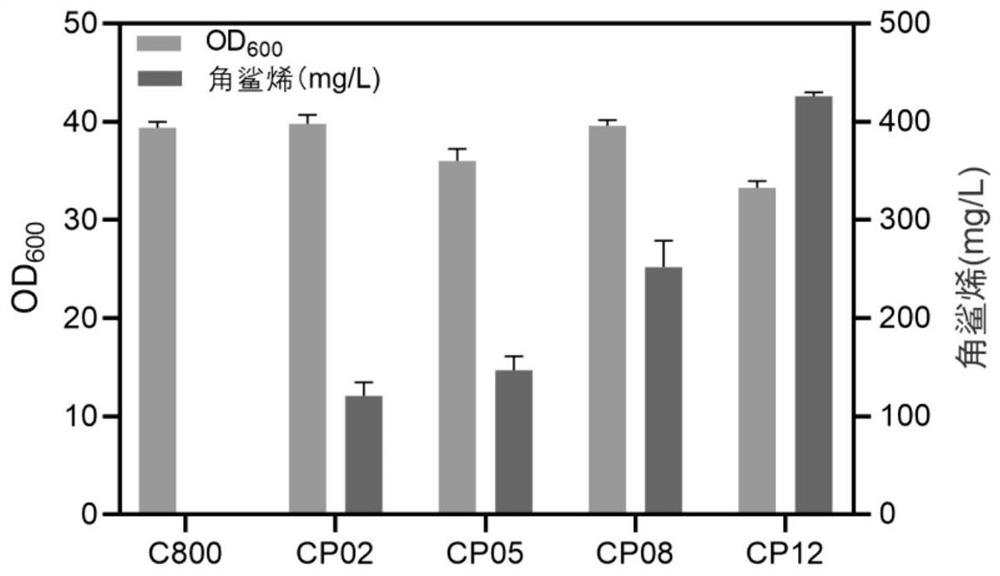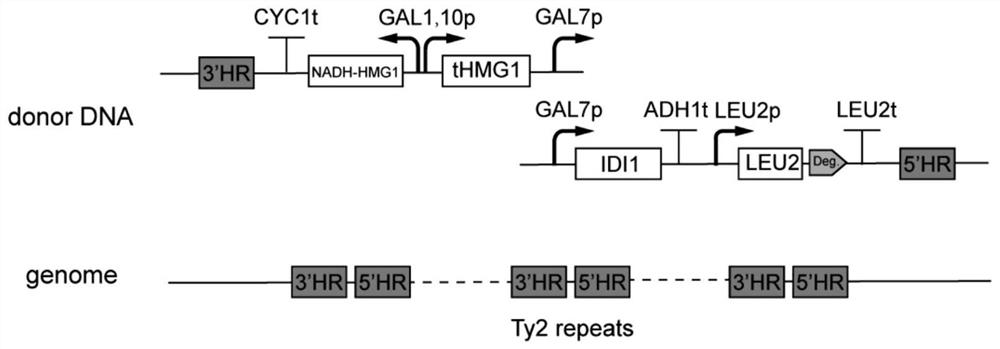Saccharomyces cerevisiae strain for synthesizing squalene and application thereof
A technology of Saccharomyces cerevisiae and squalene, applied in the field of genetic engineering, can solve the problems of limited output and long fermentation cycle, and achieve the effect of strengthening metabolic flow
- Summary
- Abstract
- Description
- Claims
- Application Information
AI Technical Summary
Problems solved by technology
Method used
Image
Examples
Embodiment 1
[0063] Example 1 Single-copy site integration of different copy numbers tHMG1 and IDI1
[0064] Select the sites ARO10, EXG1, and SPR1 of Saccharomyces cerevisiae C800, and increase tHMG1 (corresponding nucleotide sequence such as the sequence table SEQ ID NO.9) and IDI1 (the corresponding nucleotide sequence is shown in the sequence table as SEQ ID NO.10), so that the gene tHMG1 and IDI1 copies of the constructed Saccharomyces cerevisiae engineered bacteria are respectively 1, 2 or 3 copies. The strains integrating different copy numbers were fermented in YPD medium at 30°C and 220rpm for 96h to obtain a positive correlation between squalene production and copy number, as shown in figure 1 . The squalene production of strain CP02 with 1 copy of tHMG1-IDI1 was 121.2 mg / L; the squalene production of strain CP05 with 2 copies of tHMG1-IDI1 was 252.1 mg / L; 3 copies of tHMG1 - The squalene production of strain CP12 of IDI1 was 426.0 mg / L.
Embodiment 2
[0065] Example 2 Integration of multiple copy sites of tHMG1 and IDI1
[0066] In order to obtain more copy numbers, the multi-copy site Ty2 transposon was selected for the integration of tHMG1 and IDI1. The Ty2 transposon structure searched in SGD is as follows figure 2 (SGD:S000007168), the upstream and downstream homology arms are designed at the LTR site. LEU was added as a screening marker. In order to increase the integrated copy number and increase the LEU degradation tag, the genes tHMG1 and IDI1 were respectively amplified from the S. cerevisiae 800 genome with primers tHMG1-F / tHMG1-R and IDI1-F / IDI1-R. Primers Ty2-armup-F / Ty2-armup-R and Ty2-armdown-F / Ty2-armdown-F respectively amplify the upstream and downstream homology arms of the Ty2 transposon, using pY15-F / pY15-R from a commercial plasmid The plasmid backbone pY15-1 was amplified from pY15, and the above fragments (genes tHMG1 and IDI1, upstream and downstream homology arms of Ty2 transposon) were assembled u...
Embodiment 3
[0070] Example 3 Heterologous expression of NADH-dependent HMG1 regulates intracellular redox balance
[0071] The gene NADH-HMG1 derived from S. pomeroyi was synthesized (the nucleotide sequence is shown in SEQ ID NO.1, and the corresponding amino acid sequence is shown in SEQ ID NO.2), and the plasmid pUC57- NADH-HMG1, using primers NADH-HMG1-F / NADH-HMG1-R to amplify the NADH-HMG1 fragment, using primers GAL-ARMUP-F / GAL-ARMUP-R and GAL-ARMDOWN-F / GAL-ARMDOWN-R The upper and lower homology arms of the GAL site were amplified respectively, and the upper and lower homology arms of the GAL site were combined with the NADH-HMG1 fragment sgRNA using the yeast transformation kit Frozen-EZ YeastTransformation II to transform the fragment into the one constructed in Example 2 In the strain XSQ10-1 cells, spread on SD-HIS-TRP screening solid medium, culture at 30°C for 3 days to obtain strain XSQ11, pick a single colony of XSQ11 in YPD medium, culture at 30°C for 96h, squalene Compare...
PUM
 Login to View More
Login to View More Abstract
Description
Claims
Application Information
 Login to View More
Login to View More - R&D
- Intellectual Property
- Life Sciences
- Materials
- Tech Scout
- Unparalleled Data Quality
- Higher Quality Content
- 60% Fewer Hallucinations
Browse by: Latest US Patents, China's latest patents, Technical Efficacy Thesaurus, Application Domain, Technology Topic, Popular Technical Reports.
© 2025 PatSnap. All rights reserved.Legal|Privacy policy|Modern Slavery Act Transparency Statement|Sitemap|About US| Contact US: help@patsnap.com



